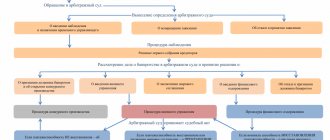Bankruptcy of a joint-stock company is intended to legally (in accordance with legislative norms) stop the business activities of a joint-stock company in the event that for some reason it cannot fully make obligatory payments to the budget, pay debts to its creditors, or pay for wages or holidays. employee benefits. Let's consider the features of bankruptcy procedures in relation to joint-stock companies, the stages of such a procedure, the grounds for its initiation and the procedure for filing an application to the court to declare a joint-stock company insolvent.
Sources of legal regulation
The grounds and procedure for declaring the insolvency of joint-stock companies are subject, with the exception of a number of features, to the general requirements of the legislation on bankruptcy of legal entities. In this regard, the sources of legal regulation of this issue include the following regulatory legal acts:
- Art. 65 and a number of other norms of the Civil Code (hereinafter referred to as the Civil Code);
- Law “On Insolvency (Bankruptcy)” dated October 26, 2002 No. 127-FZ in terms of regulation of the general bankruptcy procedure (hereinafter referred to as Law 127-FZ);
- Law “On Joint-Stock Companies” dated December 26, 1995 No. 208-FZ (hereinafter referred to as Law 208-FZ), establishing a number of features regarding the recognition of a joint-stock company and its subsidiaries as insolvent;
- Code of Administrative Offenses in terms of establishing liability for violation of legislative requirements for the bankruptcy procedure (in case of failure to fulfill the obligation to file an application, fictitious bankruptcy, etc.);
- decisions of higher courts and other judicial practice in the field of bankruptcy of legal entities and joint-stock companies in particular.
Other legislative acts can also act as sources of regulation in certain cases (for example, the Civil Code only states that a public company cannot be declared bankrupt, but the concept is given by a separate law).
Bankruptcy court decision on JSC
This subsection should consider bankruptcy as a judicial procedure.
For deliberate bankruptcy, for the inactivity of a director or founder of an OJSC, which causes harm and losses for the organization, leading to insolvency, liability is established in accordance with the Criminal Code and the Code of Administrative Offenses.
As a last resort for the creditor to repay the debts, he can file a claim in the arbitration court, as a result of which the debtor will be held liable. In the event that an OJSC wants to be declared bankrupt, the application can be submitted arbitrarily by the debtor.
In court, you can agree to a settlement between the parties. It can be concluded at any stage of the process. The initiative to conclude an agreement can be taken by both the debtor and the bankruptcy trustee under the supervision of the court. The decision can be made subject to 51% of the votes cast. If the founders are against the settlement agreement, the court can appeal the decision if it is more beneficial than further bankruptcy of the JSC.
The debtor, coming to the arbitration court with a claim to initiate bankruptcy proceedings, petitions for the appointment of a certain person. This means that the procedure is entering a manageable stage, and a check will be carried out regarding the fictitiousness of bankruptcy. The procedure is completely under the control of the court. It includes checking the accrual of penalties and interest.
All economic sanctions from the moment bankruptcy begins are terminated, the arrest imposed on the debtor’s property is lifted, enforcement proceedings are stopped, i.e. bailiffs cannot act against the debtor. Accordingly, it is possible to conclude a settlement agreement that is directly interesting to the debtor.
Reasons for starting the procedure
A joint stock company, like a legal entity of a different organizational and legal form, can be declared insolvent and subsequently liquidated only if the set of signs specified in Art. 3 and 4 of Law 127-FZ. These signs include the following:
- the joint-stock company is unable to pay employees wages or severance pay, debts to creditors, obligatory payments to the budget and extra-budgetary funds;
- the delay in fulfilling these monetary obligations is at least 3 months (the period must be continuous, i.e. the impossibility of payment must be present for the specified period without interruption);
- the delay is calculated from the date on which the monetary obligation should have been fulfilled (from the date of payment for the received goods established by the contract, the deadline for payment of wages due to the employee, etc.);
- the amount of unfulfilled obligations is taken into account on the date of filing the relevant application with the court;
- the debt that is important for identifying signs of insolvency includes all monetary obligations to creditors and employees, as well as mandatory payments (insurance and pension contributions, taxes);
- Monetary obligations include debt for goods, works and services received but not paid for, loans received and interest on them, unjust enrichment of the company, obligations to the founders and others specified in paragraph. 2 p. 2 art. 4 of Law 127-FZ.
The indicated signs for initiating the bankruptcy procedure of a legal entity in the form of a JSC must occur simultaneously. Only in aggregate can they indicate the financial insolvency of the enterprise.
Step-by-step instructions for bankruptcy of a joint-stock company
The bankruptcy procedure for a shareholder is a complex and lengthy process. It begins with the submission of an appropriate application to the judicial authority. If the court sees in the claim enough reliable facts confirming the deplorable financial situation of the debtor, then the bankruptcy process will begin, which can be divided into stages. Below we consider the stages of the entire procedure before going to court:
- Meeting of shareholders. If the results of the analysis of the company's financial condition do not satisfy the shareholders, they may decide to declare the company bankrupt. At the first sign of insolvency, shareholders' rights will be limited. Accordingly, dividends cease to be paid.
- Filing a claim in court. To submit an application, the joint-stock company must officially, in the prescribed manner, document the fact of insolvency. A single application that is not supported by appropriate documentation will not be considered by the court.
- Observation. At this stage, the judicial authority examines in detail and gives an objective assessment of the financial condition of the company. To preserve the integrity of the property, the payment of dividends is suspended and the company’s property is seized. Then a register of creditors is drawn up and the legality of their claims is examined.
- External control. Based on the results of financial research, the court may decide to restore the company’s solvency. Then an external manager is selected and approved, who is given the authority to sell part of the property in order to pay the debt. Based on the results of the work performed, the manager is obliged to draw up a conclusion, on the basis of which the court will make a decision: whether it is necessary to extend the stage of external management or whether the organization should be declared bankrupt.
- Competition proceedings. The liquidation of a joint stock company ends with the sale of property at auction in order to repay debts to lenders. Payment of monetary debts must be carried out in order of priority. When the proceeds from the sale of property are not enough to pay off the debt, they must be distributed among the lenders in proportion to the amount of the debt. In cases where funds remain after the sale, they are distributed among shareholders. When the receivership stage is completed, the company is liquidated and its shares are then no longer listed.
Stages of the JSC bankruptcy procedure
The bankruptcy procedure carried out in relation to the debtor, when it is impossible to apply measures to improve and restore the normal functioning of the joint-stock company and ending with the liquidation of the company, goes through several stages, among which are:
- submission to the court of an application by a competent person (executive body, creditor, tax service) to declare the joint-stock company insolvent if this company has the corresponding legally established characteristics;
- recognition of the application as justified and its satisfaction by the arbitration court;
- introduction of a monitoring procedure in relation to an insolvent JSC, upon the onset of which enforcement proceedings against this legal entity are suspended, and claims of creditors can be presented only in compliance with special rules; the amount of creditors' claims is established;
- carrying out financial rehabilitation, introduced by the court on the basis of a decision of a meeting of creditors, during which the debts of the enterprise are repaid and its financial position is normalized;
- external management, during which the previous management is removed from the management of the company and a new (external) management is appointed, whose actions are aimed at restoring the solvency of the joint-stock company;
- bankruptcy proceedings opened if it is impossible to normalize the financial condition of a joint-stock company, during which its assets are sold in order to satisfy the claims of creditors, pay off wage arrears, and mandatory payments.
Sequence of stages
The bankruptcy procedure does not necessarily require all of these stages. In accordance with paragraph 1 of Art. 75 of Law 127-FZ, after monitoring the JSC, the arbitration court may decide to introduce any of the subsequent stages. In addition, at each of these stages between the joint-stock company and its creditors (or other authorized persons who initiated the bankruptcy procedure) by virtue of clause 1 of Art. 150 of Law 127-FZ, a settlement agreement can be concluded.
Reasons for bankruptcy
The bankruptcy of a closed joint-stock company can be recognized on a voluntary or compulsory basis. Each of the factors has its own reasons. Common prerequisites for voluntary bankruptcy are the following circumstances:
- the inability of a closed joint stock company to recoup the costs of conducting commercial activities (production, sales, development), which entails a loss (negative profit indicator);
- decision by shareholders to engage in other types of business due to the irrelevance of current activities in the current market conditions;
- the emergence of significant disagreements between the founders of the Company, leading to dissonance.
This type of bankruptcy means that the participants of the company independently decided to liquidate it. The problem of forced bankruptcy is much more serious, when outsiders and organizations are forced to intervene in the process. There may also be several reasons for this development of events:
- inability to pay creditors;
- malicious evasion of taxes and contributions to the state;
- fact of violation of labor legal relations with employees.
Information
This is a more serious set of reasons for the bankruptcy of a closed joint stock company. They are formed in situations where the owners of the company are not able to monitor its functioning and calculate the budget. The initiation of such procedures is carried out by government bodies - tax services, various funds and other governing bodies.
Going to court
Initiation of a case of insolvency of a legal entity, in accordance with paragraph 1 of Art. 6 of Law 127-FZ, is carried out on the basis of an application from a person who has the right to submit such an application, or by an arbitration court at the location of the legal entity. The application form for declaring a joint stock company insolvent is posted by arbitration courts on their Internet resources.
In particular, in such a statement the interested person must indicate:
- name of the judicial authority;
- name and address of the applicant;
- name and postal details of the joint-stock company whose insolvency the applicant requests to recognize;
- an indication of the circumstances from which the JSC’s obligation arises, not satisfied for more than 3 months, which was the basis for sending the application;
- reference to the rules of law establishing the signs of bankruptcy;
- indication of the amount of debt and the period of delay in fulfilling the obligation;
- the operative part with the requirement to declare the JSC bankrupt;
- a list of documents attached to the application that serve as evidence in the case;
- date of document preparation, signature of an authorized person.
In addition, during one or another stage of the bankruptcy procedure, competent persons (meetings of creditors or others) will be required to submit petitions to the arbitration court to introduce the next stage of the procedure, justifying their claims.
The process of declaring a closed joint stock company bankrupt
The procedure for declaring a Closed Joint Stock Company bankrupt includes several successive stages.
Drawing up an application
This is the most important document, including the signature and seal of the manager. It should contain the following data:
- the name of the court to which the paper is addressed;
- the amount required by creditors for payment;
- the amount of debts to legal entities and individuals;
- amount of mandatory payments;
- information about the debtor’s existing property;
- amount to be paid to the arbitration manager;
- list of attached documents.
After the court rules out an attempt at deliberate bankruptcy and fiction and makes an appropriate decision, the CJSC goes through the stages of the insolvency procedure.
Observation
This is the first and mandatory measure that is taken as part of the bankruptcy procedure of a closed joint stock company. At this stage, the level of solvency of the liquidated entity is determined. Typically, the procedure is a set of measures taken by government agencies in order to ensure the integrity of the company’s property and analyze the current situation. The duration of the stage is 3-4 months.
Based on the results of monitoring and an objective assessment of the state of the closed joint-stock company, one of the following procedures may be introduced - financial recovery, external management, bankruptcy proceedings or a settlement agreement.
Financial recovery
This event is aimed at saving the company from liquidation and restoring its economy and repaying debts. For this purpose, measures are being taken to restructure the debt, a repayment schedule is being developed, which is subsequently approved by the arbitration court. At this step, the managing person of the closed joint-stock company does not have the opportunity to make decisions that could lead to an increase in the amount of debt. All actions of the arbitration manager are coordinated with the participants in the meeting of creditors. The duration of this stage of bankruptcy can reach 2 years.
External control
This measure assumes that the company is controlled externally. In accordance with the requirements of creditors, the court may appoint an external financial manager, who assumes his position for no more than one and a half years. At this stage, the debtor does not receive fines and penalties, that is, they are not accrued on his debts.
Bankruptcy proceedings
The process is carried out through the efforts of a bankruptcy trustee appointed by the court. The goal is to satisfy creditors' claims by selling the property at public auction. In general, this stage of bankruptcy of a closed joint-stock company looks like this:
- the bankruptcy trustee carries out an inventory of the debtor’s property;
- Next, a search takes place for a specialist in assessing property in monetary terms;
- the entire state is realized;
- the money received goes towards debts.
The stage lasts up to six months.
A bankrupt closed joint stock company is a company that has ceased operations and does not have the ability to transfer rights. At this stage, a liquidation balance sheet is drawn up, which is approved by all members of the Society. A stamp is placed. You also need to pay a state fee (4,000 rubles) and obtain a certificate from the Pension Fund stating that there is no debt.
Settlement agreement
According to the law, a settlement agreement in case of bankruptcy of a closed joint-stock company can be concluded at any stage of the resolution of the case. An agreement represents the fact that the parties have agreed to the possibility of out-of-court settlement of certain disputes. In this situation, the court terminates the case, the company repays the debt and continues its commercial work. In practice, an event can only be carried out if certain conditions are met. They relate to the mandatory presence of bankruptcy creditors, the fact of repayment of debt to them, and the consent of other creditors.
Information
The document is drawn up in writing; it must include the signatures of all parties, as well as a section that contains basic information: amounts, procedures, terms for repaying the obligations of a closed joint stock company. Participants have several options to pay off their debt obligations. This is the payment of compensation amounts, direct repayment of debts, including restructuring and novation. After this, the agreement comes into force.
Bankruptcy due to the fault of shareholders
Law 208-FZ (paragraph 2, paragraph 3, article 2) provides for such a concept as bankruptcy due to the fault of shareholders. By virtue of this norm, guilty actions of shareholders (or other persons who have the authority to make decisions binding on the company) should be understood as actions committed by these persons with the knowledge that they would result in bankruptcy.
The peculiarities of bankruptcy in this case are determined by paragraph. 1 clause 3 art. 2 of Law 208-FZ. By virtue of this provision, when establishing the guilty actions of shareholders or other persons that resulted in the insolvency of the company, such persons bear subsidiary (i.e., additional) liability. This means that if the company's funds are insufficient to satisfy all financial requirements, such persons are obliged to satisfy these requirements from their own funds.
Main theses of the bankruptcy of OJSC
It is necessary to carefully check the composition of accounts payable and receivable, because debts are an inseparable component of every enterprise.
When counterparties collect debts and there is nothing to pay them off, you need to seek the help of a specialist. In addition, the very first thing you should do is pay off your tax debt, because... The tax office is the first at the beginning of the bankruptcy process.
The purpose of Russian bankruptcy law is to achieve balance between all interested parties (debtor and creditor) in the process of proceedings, i.e. maximum recovery of the debtor while satisfying the creditor's interests.
Bankruptcy of an OJSC is a complex complex that is aimed at implementing the following points:
- Bankruptcy prevention, so-called rehabilitation;
- Restoring the debtor's solvency;
- Liquidation moment.
Bankruptcy of a subsidiary due to the fault of the principal
By analogy with the guilty actions of shareholders that led to the bankruptcy of a joint-stock company, para. 3 p. 3 art. 6 of Law 208-FZ establishes the concept of guilty actions of the main company, as a result of which the insolvency of the subsidiary company occurred. Such actions must also have an indication that the parent company knew in advance that its mandatory instructions would lead to bankruptcy of the subsidiary.
Such an action is the only exception allowing the parent company to bear responsibility for the obligations of the subsidiary. In this case, it bears subsidiary liability for those obligations that the subsidiary could not satisfy at the expense of its own assets. Moreover, para. 4 of this norm specifically indicates the right of shareholders to claim compensation for losses that were caused to a subsidiary as a result of mandatory instructions from the parent company.
What is bankruptcy
The bankruptcy procedure of an enterprise is the recognition of its inability to answer to its creditors for existing obligations, which are most often expressed in monetary terms. Bankruptcy can be carried out in relation to government agencies, religious organizations, parties, etc.
The procedure can be initiated by the business entity itself, which has significant debts, or by its partners, to whom it owes.
Only a judge of the Arbitration Court can declare an enterprise bankrupt by making the appropriate decision. This procedure is regulated by the provisions of regulations, for example, the Civil Code of the Russian Federation, the insolvency law, etc.
Attention! Declaring an enterprise bankrupt assumes that its management will be transferred to third parties - specialists who manage problem enterprises. After a company is declared bankrupt, all mutual settlements with each creditor are carried out not directly, but through an appointed manager in compliance with the existing priority.
Results
In conclusion, here are the final points:
- regulation of the bankruptcy procedure of a joint-stock company is carried out by general rules on insolvency, taking into account the specifics established by the law “On Joint-Stock Companies”;
- the insolvency procedure of a joint-stock company can be started only if all the signs of bankruptcy established by law are present;
- a decision to declare a JSC insolvent can be made by an arbitration court on the basis of an application from a person who, by force of law, has the right to submit such an application (the executive body of the company, the creditor, the tax service);
- the bankruptcy procedure is implemented in several stages, and not every stage provided for by law is mandatory;
- the procedure can be completed on the basis of a settlement agreement at any stage of its implementation;
- in the event of culpable actions of shareholders or the main company that resulted in the insolvency of the joint-stock company or subsidiary company, respectively, the guilty persons (including the main company) bear additional responsibility and are obliged at their own expense to satisfy the claims of creditors that were not satisfied from the assets of the company as a result of bankruptcy.
You can find more complete information on the topic in ConsultantPlus. Full and free access to the system for 2 days.
Causes and types of bankruptcy
There are several reasons leading to the financial insolvency of a company. In general, they can be divided into two categories: objective and subjective criteria for insolvency and bankruptcy.
The first includes:
- general economic crisis;
- gaps in the legislative framework related to business activities;
- instability in the tax, financial or credit systems;
- problems with business partners;
- political upheavals.
Subjective factors include:
- decline in production volume;
- low product quality;
- inflated costs;
- lagging behind technical progress;
- mismatch with market demand.
Lawyers also distinguish several types of bankruptcy:
- Temporary or conditional . Characterized by an excess of expenditure over revenue. In such a situation, the financial condition of the company can still be restored, for which the arbitration court makes a decision to introduce external management. Read about external management as a bankruptcy procedure here.
- Fictitious . It is associated with an attempt by the owner to delay the payment of debts through an untruthful bankruptcy filing. May have criminal consequences. What is fictitious and deliberate bankruptcy? Read more here.
- Deliberate . It is implemented by the deliberate theft of an enterprise's assets by its management. Also prosecuted by law. Information on liability under the Criminal Code of the Russian Federation for deliberate bankruptcy is here.
- Real . Wrong management decisions lead to it. In this situation, the arbitration court declares the company bankrupt.
Why is this procedure needed?
Let's consider the opportunities that bankruptcy provides to participants in this procedure.
For the business owner
Bankruptcy allows owners to:
- Protect the company's property from legal penalties for a time.
- Remove the existing arrests that have been imposed on the property of the debtor enterprise, which will allow them to be used until a certain point.
- Get some deferment of payments on existing debts.
- Get the opportunity to restructure the debt to creditors.
- Partially write off the amount of debt or interest and penalties.
For the lender
Stressed businessman
Bankruptcy of an LLC with debts allows, first of all, if the debtor has property, to receive the debt, albeit not in full, but in sufficient part.
If the debtor’s company has no funds and property, creditors after bankruptcy have the opportunity to write off the overdue debt and close their relationship with it.
What will be the consequences of declaring the insolvency of an LLC (bankruptcy of an LLC)
Let's study the consequences of bankruptcy for each of the parties to the relationship.
For founders
After a judge makes a decision declaring an organization bankrupt, it closes down. Declaring a company bankrupt leads to the fact that penalties and fines cease to accrue on the debt.
If all the property was used to pay off debts, then the owners receive little in bankruptcy. They lose the right to their shares in the authorized capital of the company. But no recovery action can be taken regarding their personal property. In addition, the owners can open a new company.
For the director
In case of bankruptcy, the head of the company is removed from its management. If, as a result of studying the case materials, it turns out that bankruptcy was the reason for the deliberate bringing of the enterprise to losses, then both the director of the company and its chief accountant may be held liable.
A director may be prohibited from holding this position for a certain period of time due to the bankruptcy of the company.









